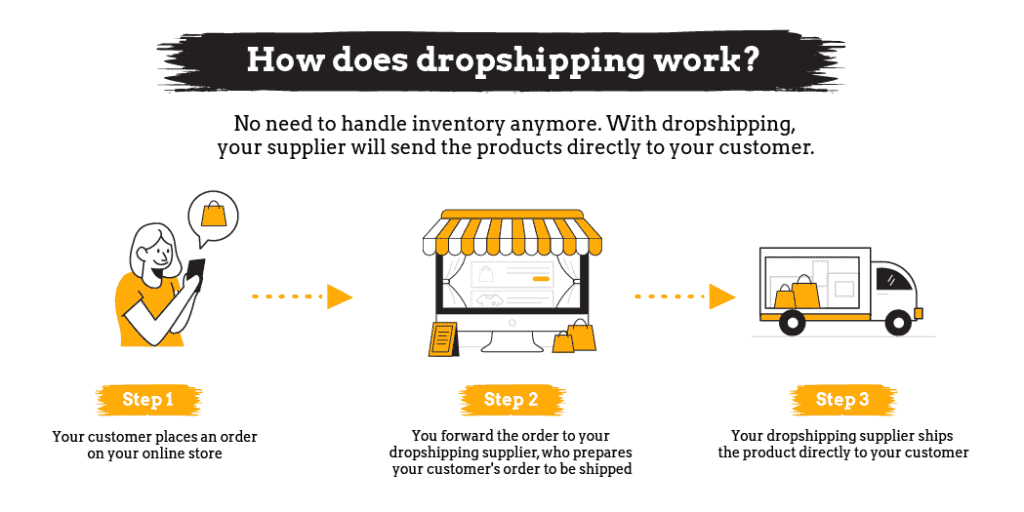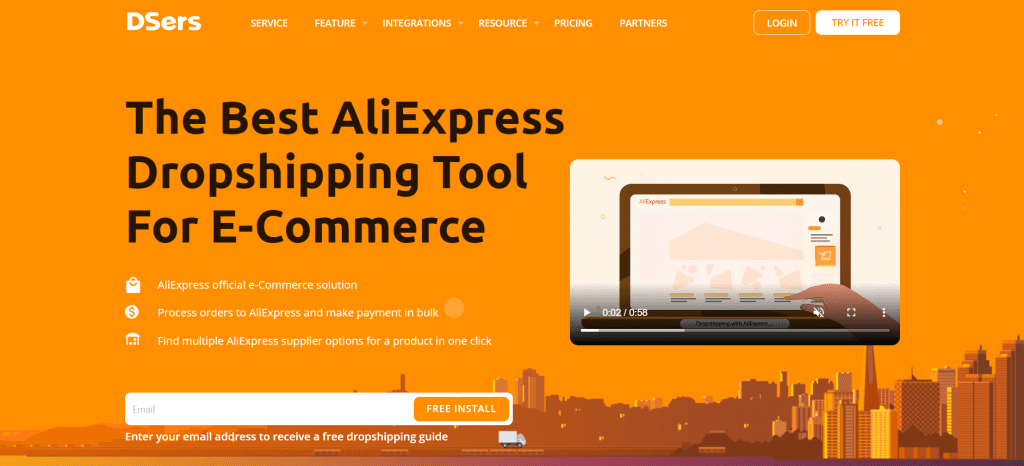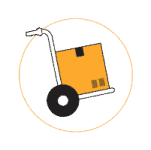Dropshipping is a business model where retailers don't keep goods in stock.
Instead, when a customer makes a purchase, the retailer simply passes their customer's information to a supplier, who ships the product directly to the customer's door.
One of the upsides of dropshipping is that it lets entrepreneurs offer a wide range of products on their ecommerce stores without having to store them in their inventory.
There are several ways of getting the information about the customer's order to a supplier when dropshipping. As you may have guessed, dropshipping with CSV is one of those ways!
This article is going to answer a few common questions about dropshipping with CSV and help you decide if it's a fulfillment method that's right for you.
What are the 3 dropshipping fulfillment options?
As previously mentioned, dropshipping is a business model that involves transferring the customer's order information to a supplier, who should handle the packaging and shipping of the product(s).
This step of forwarding the order to your dropshipping supplier is illustrated in step two of the infographic below:

To fulfill your customer's order, a supplier must know a couple of things. For example, the customer's ordered products, name, and shipping address.
The transfer of this information is part of the fulfillment process, and there are three main options for it.
The “classic” option is called manual fulfillment.
This is when you take your customer's order information and manually order the same item from your supplier.
For example, some people still do this when they are dropshipping with AliExpress.
They manually add the product(s) to their cart, enter the customer's shipping information, and place the order.

This fulfillment option is by far the least convenient one. It's doable for when you are just starting out and are getting less than ten orders per day, but any more than that, and fulfilling your orders will become a time-consuming activity.
A more convenient method of fulfillment is using .csv files (CSV dropshipping). This is when you export your customer's order information from your ecommerce platform as a .csv file and send it to your supplier directly.
We will give a more detailed explanation about this fulfillment option soon, including its pros and cons!
Finally, fulfillment options exist based on an integration app. These come in different variations of convenience but are generally considered as the least time-consuming fulfillment options.
Some integrations require only a few clicks to fulfill your orders. For example, you might have heard of DSers, a popular integration for people that are dropshipping with AliExpress that helps them automate the fulfillment process.

Sometimes, you will also come across suppliers offering a fully automated fulfillment integration.
For example, by partnering with uDroppy, orders can be fulfilled with just a single click.
Furthermore, Syncee is a platform with an auto-order feature, which means new orders will directly get sent to your dropshipping supplier.
What is CSV fulfillment for dropshipping?
If you have been getting started with dropshipping, you might have heard of fulfillment with CSV. Or, maybe you are looking it up because it is the only fulfillment option your supplier offers.
Whatever it is, don't worry. As promised, we will explain it!
CSV fulfillment for dropshipping is a fulfillment option where the customer's order information is sent to a dropshipping supplier through a .csv file. This file can often be easily exported from your ecommerce store platform, making it easy to transfer to a supplier.
Data that is included in an exported .csv file may contain information like:
- The products that were ordered (including their SKUs)
- The customer's name
- The customer's shipping information
- And more.
Often, ecommerce platforms offer a feature that allows you to export the orders you have received to a .csv file in bulk. Here is an example of how it looks for Shopify:

Once you have the correct .csv file, you will only have to send it to your supplier, and they will handle the rest – or import it into their system!
Dropshipping with CSV fulfillment comes with some pros and cons; let's go over them now!
Pros of dropshipping with CSV fulfillment
Let's take a look at CSV fulfillment from the positive side. What are its pros?
You don't have to place all orders manually
When doing manual fulfillment, you will have to go through all of your orders one by one and place an order for them on your supplier's website.
This is a highly cumbersome and time-consuming process, especially when scaling your dropshipping store and getting multiple orders per day.
CSV fulfillment allows you to export all your daily orders into one file and send all of them to your supplier at once.
A .csv file is often easy to export from your ecommerce platform
Most ecommerce platforms support exporting your orders to a .csv file.
Because of this, dropshipping with CSV fulfillment is made possible and offers dropshippers a fast way of transferring all their orders to the supplier.
Cons of dropshipping with CSV fulfillment
Now, let's think about the cons of dropshipping with CSV fulfillment too!
Updating the tracking numbers can still require manual work
Once the supplier has shipped out all packages, he will collect the tracking numbers for them and send you a .csv file back containing your order numbers and the corresponding tracking numbers.
Now, if you aren't using a dedicated app for this (more on that later), you will have to manually copy and paste all tracking numbers into your ecommerce store platform for your customers to get a shipping update.
Still requires you to put in some work for fulfilling your orders each day
When you are dropshipping with CSV fulfillment, you will have to go through all the steps needed to fulfill your orders using a .csv file every day.
This means creating a new export each day, sending your supplier a .csv file each day, and updating the tracking numbers each day!
Luckily, there is a solution to decrease the amount of work required for this task. Rather than downloading and tracking CSV after CSV, an automation software like Zapier can help you to automatically generate an up-to-date order log.

That way, you can connect Shopify to your favorite spreadsheet app and automatically log orders in real-time.
Not as convenient as integration fulfillment
While CSV fulfillment is much better compared to manual fulfillment, it's still not up to par with integration fulfillment in most cases.
Why?
When doing integration fulfillment, your supplier is essentially connected with your store, making fulfilling the orders and updating the tracking information as easy as clicking a few buttons.
Why do some dropshipping suppliers use CSV fulfillment?
As we have seen, CSV fulfillment is not the best fulfillment option out there. Don't get me wrong, it will be sufficient for a lot of people, but integration fulfillment will often be a more convenient fulfillment method.
So, if CSV fulfillment is not the best fulfillment option, then why do some dropshipping suppliers use it?
In most cases, the reason is simple. They simply didn't take the effort yet to develop an integration that connects them to some of the popular ecommerce platforms like Shopify.
If a supplier does offer integration fulfillment for their dropshipping clients, you will often see an “integration” tab somewhere on their website:

The 5 steps of dropshipping with CSV fulfillment
If you are planning on doing dropshipping with CSV fulfillment, then here you will read a comprehensive step-by-step guide about it.
You may have to use CSV fulfillment when working with certain suppliers, like a few that you will find on SaleHoo.
However, dropshipping suppliers aren't the only ones using CSV fulfillment. For example, CSV fulfillment is a pretty standard fulfillment method among dropshipping agents!
But don't worry; it doesn't matter if you are using CSV fulfillment in combination with a supplier or an agent. The steps will stay the same. Let's look into them!
1. Export your orders to a .csv file
The first is to export your orders to a .csv file.
If you are using Shopify, you can do this using the “Export” button on the orders page:

2. Modify the .csv file if necessary
Once you have exported the .csv file, the next step is to see if your exported file needs modification before it is sent to your supplier.
More often than not, your exported .csv file will contain information that your supplier doesn't require and only makes things more complicated.
For example, here are some things that will be included in your .csv file when exporting orders on Shopify but are often useless for your supplier:
- Discount code that was applied to the order
- Payment method
- “Fulfilled at” date
- Currency that the order was paid in
And you will find many more of these as well in the .csv file. To take a look at the entire order export CSV structure, check out the Shopify manuals here.
Now, most suppliers and agents only require a small part of the data that is exported to the .csv file. You will see the most requested data in the template that will be discussed in a moment.
So, to obtain the correct .csv file, you could modify the file yourself in a program like Excel. However, you can also use a Shopify data exporter app such as EZ Exporter, which allows you to select which data you want to export beforehand.

This way, you won't have to modify the .csv file yourself after exporting it!
3. Send the .csv file to your supplier or agent
Once the .csv file is ready, you should send it to your supplier or agent.
This can be done in any way you like, for example, through a communication app, email, or another medium.
Once your supplier or agent gets the .csv file, they will be able to start packaging and sending out the products!
4. Receive tracking information from your supplier or agent
A few days after the packages have been sent out, your supplier or agent will receive the tracking numbers for them.
Once they receive the tracking numbers, they will create a .csv file with a tracking number added for each order number. After it is completed, they will send the file containing the tracking information back to you.
5. Update the tracking information on your ecommerce platform
Now, it's your job to update the tracking information on your ecommerce platform and consequently let your customers know that their order has been shipped.
Some people copy and paste all tracking numbers for each order manually, but as you may imagine, this becomes a time-consuming task if you are getting lots of orders.
An alternative way of updating the tracking information is using a Shopify app like Mass Fulfill:

It's an app where you can upload the .csv file your supplier or agent has sent you. Then, Mass Fulfill will automatically fulfill the orders in that file and update their tracking information.
Convenient, right?
And that's it! You have now fulfilled your dropshipping orders.
CSV template for dropshipping in 2023
When exporting a .csv file from your Shopify orders, you will get a file containing 66 columns.
In other words, it contains way more information compared to what is needed for your supplier or agent to fulfill the order.
To make dropshipping with CSV fulfillment a little easier, we have created a template containing the most often required information from suppliers and agents. Using this template for your .csv file, your supplier or agent will likely have all the information they need to ship out the products!
For readability purposes, we will translate the table so that the columns of the template are displayed vertically:
| Column | Example |
| Name (order number) | #1234 |
| Lineitem quantity | 1 |
| Lineitem name | Fish cat toy |
| Lineitem SKU | 12354898 |
| Shipping Name | Dennis Clark |
| Shipping Address1 | 4856 Maple Avenue |
| Shipping Address2 | Ground floor |
| Shipping City | Cincinnati |
| Shipping Zip | 45208 |
| Shipping Province | Ohio |
| Shipping Country | United States |
| Shipping Phone | 209-279-5835 |
Note: Be aware that this list is based on Shopify's order export CSV structure. To learn more about the mentioned data, visit Shopify's help manual here!
Conclusion
Dropshipping with CSV is a fulfillment method that will save you a lot of time when you are used to fulfilling your orders manually.
Now, you will only have to export your orders to a .csv file and send them to your supplier!
However, besides being much more convenient compared to fulfilling orders manually, there is an even more efficient fulfillment option, using integrations.
Nevertheless, some dropshipping suppliers or agents simply don't offer any integrations, and in that case, CSV fulfillment is a great solution.
If you have any more questions about fulfilling the orders for your dropshipping store, don't forget to ask them in the comments below!
Have a great rest of your day!













